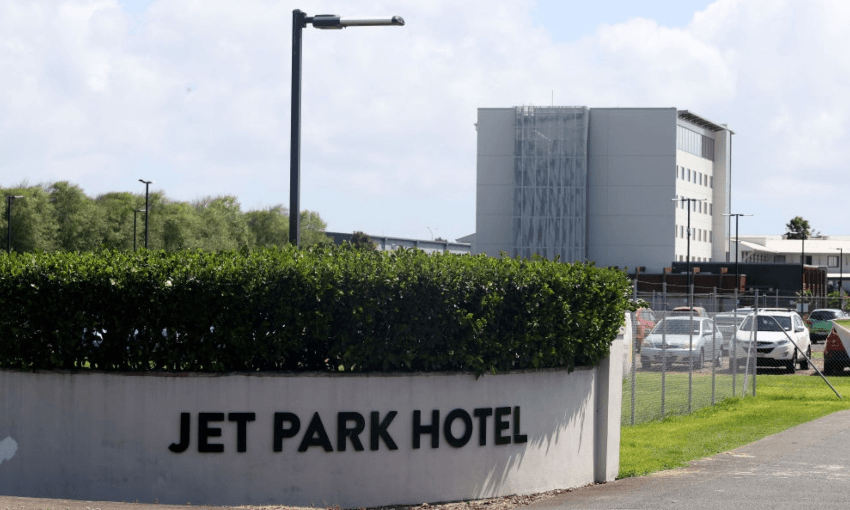The current delta reproduction rate will see three-figure daily numbers soon. That presents a challenge for hospitals. Without high compliance and vaccination rates, it could soon lead to overrun contact tracing systems and an even steeper rise.
The 1pm briefing yesterday brought sobering, if unsurprising, confirmation of the trajectory of the delta outbreak. There were 75 cases across the previous fortnight that remained unlinked – that is, no one could say from whom they caught the virus.
While unanswered questions about Covid’s reach in Northland and parts of Waikato meant level three restrictions would be extended, in both regions the ambition is still to extinguish every ember in the short term. Not so Auckland. “Covid-19 is spreading in Auckland,” said the minister overseeing the response, Chris Hipkins. “And the number of locations we’re seeing cases pop up is increasing.”
Auckland’s reproduction number, Hipkins confirmed, sits around 1.2-1.3. That means that, between them, every four people who are positive will pass Covid on to another five.
With those increasing case numbers, so increases the total number of “active cases”. (Ten days after symptoms started and when there have been no symptoms for 72 hours, a case is judged “recovered”.)
Here’s the situation from the last couple of weeks:
It’s no wonder, therefore, that Hipkins said yesterday the capacity of quarantine facilities to house people who had been infected would soon reach breaking point, and plans were being explored to allow home isolation for people who had tested positive.
“As we are expecting to see the number of cases increasing, the sustainability of putting everybody who is a positive case into MIQ starts to seriously be drawn into question. We have been working for some time now on a home isolation model for positive cases.”
Of the increasing case count, he said: “There is no question. We’re going into a period where we are likely to see quite significant growth in cases.”
Significant growth. What does that mean? I asked Shaun Hendy, who has led modelling work at Te Pūnaha Matati, what we might be looking at in Auckland a couple of weeks from now, based on a reproduction rate of 1.25. On that curve, Auckland could expect to see daily case counts of greater than 100 in a fortnight’s time, he said. He stressed, however, echoing Hipkins, that “vaccinations should take the edge off that if we can keep the social distancing and contact tracing at the same levels”.
The obverse is just as true, of course. Cabinet will decide on Monday whether to move Auckland to the second step of the level three “road map”, which would see retail welcome back customers, pools, libraries and museums reopen, and outdoor gathering limits increase to 25. All would come with distancing and mask requirements, but equally carry increased risks.
There is obvious pressure building, meanwhile, on contact tracing.
“Unfortunately, the trends in the number of active contacts being managed suggest contact tracing is going to be increasingly challenging,” said Matthew Parry, a senior lecturer in statistics at the University of Otago, in comments to the Science Media Centre. “Currently, the number of active contacts being managed is doubling every eight to nine days, which is faster than the growth in the number of new cases.”
Speaking yesterday on the new cases that were unlinked, Bloomfield said, “interviews on many of these are still to start". That was by way of indicating that the unlinked number might drop, but it underscored, too, the challenges contact-tracing teams contend with. The Ministry of Health position is that as many as 6,000 contacts can be traced a day under surge protocols; as Marc Daalder has pointed out, at current rates of tracing, the seams would start to split at 200 new cases a day. It is made all the more difficult when your new positive cases include people who live on society's margins, and sometimes are reluctant, or even stonewall, anyone official asking them questions.
Contact tracers are facing a powerful headwind, and as heroically as they might run into that gale, even running to stay in the same spot is a stretch. Any lag in contact tracing is both a symptom of, and an exacerbating factor in, higher daily case numbers. It makes officials’ reported refusal to expand contact-tracing capacity even more perplexing.
All these numbers, of course, lead inexorably towards compounded pressure on our health system, where they are measured in hospitalisations, overwhelmed intensive care units and deaths. Asked last night what sort of new case tally would force Middlemore Hospital into surge mode, shuttling Covid patients between hospitals and redeploying resources needed elsewhere, Gary Jackson, director of population health at Counties Manukau Health, said this: "I think we're getting worried if it's above 100 cases per day."

